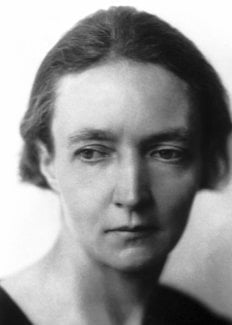Irène Joliot-Curie
Biographical

Irène Curie, born in Paris, September 12, 1897, was the daughter of Pierre and Marie Curie, and since 1926 the wife of Frédéric Joliot. After having started her studies at the Faculty of Science in Paris, she served as a nurse radiographer during the First World War. She became Doctor of Science in 1925, having prepared a thesis on the alpha rays of polonium. Either alone or in collaboration with her husband, she did important work on natural and artificial radioactivity, transmutation of elements, and nuclear physics; she shared the Nobel Prize in Chemistry for 1935 with him, in recognition of their synthesis of new radioactive elements, which work has been summarized in their joint paper Production artificielle d’éléments radioactifs. Preuve chimique de la transmutation des éléments (1934).
In 1938 her research on the action of neutrons on the heavy elements, was an important step in the discovery of uranium fission. Appointed lecturer in 1932, she became Professor in the Faculty of Science in Paris in 1937, and afterwards Director of the Radium Institute in 1946. Being a Commissioner for Atomic Energy for six years, Irène took part in its creation and in the construction of the first French atomic pile (1948). She was concerned in the inauguration of the large centre for nuclear physics at Orsay for which she worked out the plans. This centre was equipped with a synchro-cyclotron of 160 MeV, and its construction was continued after her death by F. Joliot. She took a keen interest in the social and intellectual advancement of women; she was a member of the Comité National de l’Union des Femmes Françaises and of the World Peace Council. In 1936 Irène Joliot-Curie was appointed Undersecretary of State for Scientific Research. She was a member of several foreign academies and of numerous scientific societies, had honorary doctor’s degrees of several universities, and was an Officer of the Legion of Honour. She died in Paris in 1956.
Jean Frédéric and Irene Joliot-Curie had one daughter, Helene, and one son, Pierre.
This autobiography/biography was written at the time of the award and first published in the book series Les Prix Nobel. It was later edited and republished in Nobel Lectures. To cite this document, always state the source as shown above.
Irène Joliot-Curie died on March 17, 1956.
Nobel Prizes and laureates
Six prizes were awarded for achievements that have conferred the greatest benefit to humankind. The 12 laureates' work and discoveries range from proteins' structures and machine learning to fighting for a world free of nuclear weapons.
See them all presented here.
